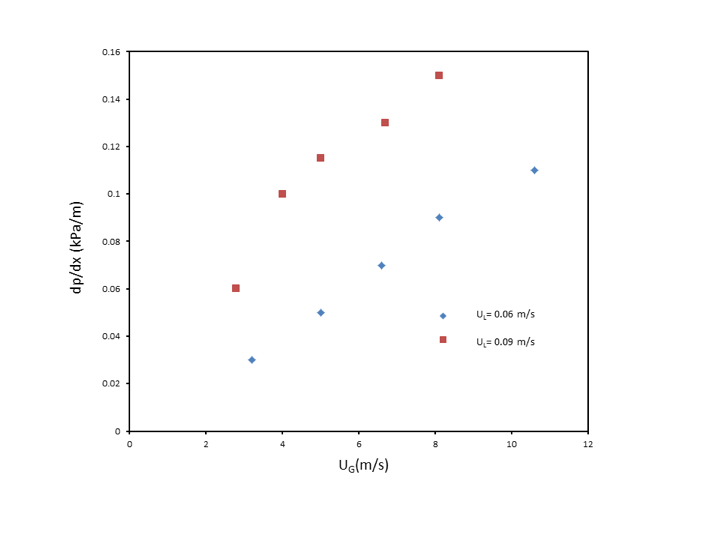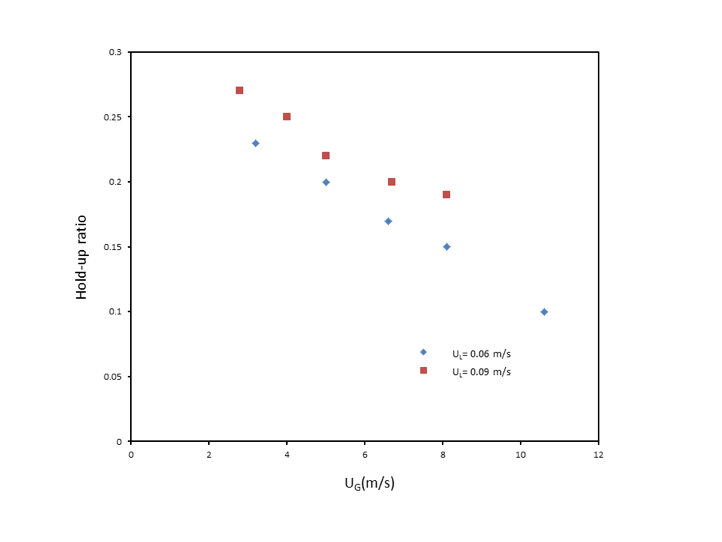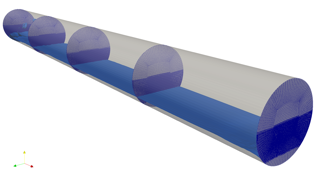58th Annual Report on Research 2013 Under Sponsorship of the ACS Petroleum Research Fund
Reports: ND952177-ND9: Direct Numerical Simulation and Experiment of Gas-Liquid Flow in Horizontal Pipelines: A New Approach
Marcus Herrmann, DEng, Arizona State University
Kangping Chen, PhD, Arizona State University
In the reporting period, work has been performed to address both the experimental and numerical tasks outlined in the proposal. On the experimental side, initial experiments were performed for water-air flow in the 1-in. inner diameter pipe. Several measurements were carried out for the pressure drop and liquid hold-up ratio in the fully developed region. On the numerical side, initial simulations identified several algorithmic improvements that would enhance the accuracy of the proposed simulations. These improvements have been implemented in the simulation framework and simulations of the proposed flow regimes have commenced. <>Experimental Work
Initial experiments were performed for water-air flow in a 1-in. diameter pipe at room temperature. The entrance configuration is that of a splitter plate placed in the middle of the pipe separating water and air, with air entering from the top. At a distance of 200 pipe diameters downstream and over a length of 6 m, pressures were measured, and time-averaged pressures were used to calculate the pressure gradient (Fig. 1) for 5 different superficial gas velocities and 2 different liquid superficial velocities. Liquid hold-up ratios were also measured downstream (Fig. 2). The flows observed range from stratified smooth flow to wavy flows.
Fig. 1 Time-averaged pressure gradient as a function of gas and liquid superficial velocities.
Fig. 2 Liquid hold-up ratios as a function of gas and liquid superficial velocities.
<>Simulation Work
Initial simulations of the developing liquid/gas flow in the pipeline for smaller liquid hold ups using the distance function level set approach to describe the motion of the phase interface in the development and fully developed zone have helped identify some shortcomings in the methodology that have been successfully addressed in the reporting period. These are described in more detail in the following sections. The changes have led to a significantly improved simulation tool enabling us to address the flow regimes described in the proposal in the current project period. <>Conservative Level Set Approach
Distance function level set approaches are prone to volume conservation errors that would potentially have a detrimental impact on the accuracy of the simulation results. While refining the level set meshes can mitigate these, such an approach would increase computational cost. Instead, replacing the distance function level set with a conservative level set approach was identified as a superior approach and work was performed in the reporting period to implement the approach by Olsson et al. (2007) with modifications due to Desjardins et al. (2008) into the Refined Level Set Grid method. The resulting solver is based on a conservative fifth-order WENO approach for the convective terms and uses phase interface reconstructed normal vectors from a parallel Fast Marching Method for the necessary re-initialization equation. Code verification using the Method of Manufactured solutions (Oberkampf 2004) have been successfully completed in the reporting period. Simulations of the developing pipe flow using the improved level set approach have commenced in the current project period. <>Flow Solver Mesh Refinement Strategies
The establishment of different flow regimes in the two-phase flow pipe depends on the dynamics of the phase interface itself. As such special care must be taken that the dynamics are captured with high accuracy, necessitating fine meshes in the vicinity of the evolving phase interface. The originally proposed flow solver uses a structured cylindrical mesh. Initial simulation results for the stratified smooth (SS) and stratified wavy (SW) regimes did however indicate that due to the structured nature of the mesh, significant mesh resources would be wasted in regions where the phase interface does not exist. Therefore we have switched to a fully unstructured formulation that conserves mass, momentum, and crucially important, kinetic energy. The flow solver is combined with an anisotropic, directional mesh refinement tool to generate high resolution meshes in the vicinity of the pipe wall boundary layers and the evolving phase interface, see Fig. 3, resulting in meshes with significantly reduced mesh counts. In the reporting period, coupling routines between the unstructured flow solver and the level set solver have been successfully implemented and verified. Simulations using the unstructured flow solver for the flow regimes outlined in the proposal have commenced in the current project period.
Fig. 3 Mesh layout SS to SW transition regime simulation.
<>Consistent Momentum Transport
The presence of strong shear at the phase interface combined with the large density ratio of water-air can cause numerical instabilities in level set based methods due to an inconsistent transport of mass via the level set and momentum. To overcome this problem, we have implemented a Consistent Rescaled Momentum Transport Method (Ghods & Herrmann 2013) in the unstructured flow solver. The method is based on the concept of initially transporting mass and momentum in a discretely consistent manner in the flow solver and then rescaling momentum to make it consistent with the level set transported mass. Consistent mass and momentum transport in the flow solver is achieved using an existing geometric based Volume-of-Fluid approach. Verification tests performed in the reporting period indicate that the resulting scheme is stable even in the presence of extremely large density ratios (order 1 million) and is thus ideally suited for the proposed simulations. <>Immersed Boundary Treatment of the Level Set Scalar
As described in the proposal, an immersed boundary treatment of the level set scalar to account for the circular cross-section of the pipe on the Cartesian mesh of the Refined Level Set Grid method has been implemented and verification tests have been successfully completed. References
á O. Desjardins and V. Moureau and H. Pitsch, An accurate conservative level set/ghost fluid method for simulating turbulent atomization, J. Comput. Phys., 227(18), 8395-8416, 2008.
á S. Ghods and M. Herrmann, A consistent rescaled momentum transport method for simulating large density ratio incompressible multiphase flows using level set methods, Physica Scripta, T155, 014050, 2013.
á William L. Oberkampf, Verification and validation in computational simulation, In 2004
á Transport Task Force Meeting, Salt Lake City, UT, 2004.
á E. Olsson and G. Kreiss and S. Zahedi, A conservative level set method for two phase flow II, J. Comput. Phys., 225(1), 785-807, 2007.
Copyright © 2014 American Chemical Society














